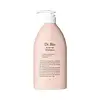What's inside
What's inside
 Key Ingredients
Key Ingredients

 Benefits
Benefits

 Concerns
Concerns

 Ingredients Side-by-side
Ingredients Side-by-side

Water
Skin ConditioningCocamidopropyl Hydroxysultaine
CleansingDisodium Laureth Sulfosuccinate
CleansingSodium C14-16 Olefin Sulfonate
CleansingGlycerin
HumectantSodium Chloride
MaskingDipropylene Glycol
HumectantHydroxyacetophenone
AntioxidantCaprylyl Glycol
EmollientPolyquaternium-10
Prunus Amygdalus Amara Kernel Oil
MaskingHaematococcus Pluvialis Extract
AntioxidantCamellia Sinensis Leaf Extract
AntimicrobialSodium Cocoyl Alaninate
Citric Acid
BufferingPyrus Malus Leaf Extract
Skin ConditioningTetradecene
EmollientHexadecene
SolventDisodium EDTA
Vanilla Planifolia Fruit Extract
Skin ConditioningJasminum Officinale Flower Water
MaskingButylene Glycol
HumectantEthylhexylglycerin
Skin Conditioning1,2-Hexanediol
Skin ConditioningRosa Centifolia Flower Water
Skin ConditioningSodium Hyaluronate
HumectantDipotassium Glycyrrhizate
HumectantEriobotrya Japonica Leaf Extract
Skin ConditioningMorus Alba Leaf Extract
Skin ConditioningLeonurus Sibiricus Extract
Skin ConditioningWater, Cocamidopropyl Hydroxysultaine, Disodium Laureth Sulfosuccinate, Sodium C14-16 Olefin Sulfonate, Glycerin, Sodium Chloride, Dipropylene Glycol, Hydroxyacetophenone, Caprylyl Glycol, Polyquaternium-10, Prunus Amygdalus Amara Kernel Oil, Haematococcus Pluvialis Extract, Camellia Sinensis Leaf Extract, Sodium Cocoyl Alaninate, Citric Acid, Pyrus Malus Leaf Extract, Tetradecene, Hexadecene, Disodium EDTA, Vanilla Planifolia Fruit Extract, Jasminum Officinale Flower Water, Butylene Glycol, Ethylhexylglycerin, 1,2-Hexanediol, Rosa Centifolia Flower Water, Sodium Hyaluronate, Dipotassium Glycyrrhizate, Eriobotrya Japonica Leaf Extract, Morus Alba Leaf Extract, Leonurus Sibiricus Extract
Water
Skin ConditioningCocamidopropyl Betaine
CleansingDisodium Laureth Sulfosuccinate
CleansingSodium Cocoyl Isethionate
CleansingSodium Chloride
MaskingHydrolyzed Rice Protein
Skin ConditioningButyrospermum Parkii Butter
Skin ConditioningCocos Nucifera Oil
MaskingTocopheryl Acetate
AntioxidantCitric Acid
BufferingCoco-Glucoside
CleansingSodium Lauroyl Sarcosinate
CleansingHydroxypropyl Guar Hydroxypropyltrimonium Chloride
Glyceryl Oleate
EmollientPolyquaternium-7
Polyquaternium-10
Polyquaternium-11
Acrylates Copolymer
Phenoxyethanol
PreservativeCocamide Mipa
EmulsifyingSodium Benzoate
MaskingGlycol Distearate
EmollientBenzyl Alcohol
PerfumingEthylhexylglycerin
Skin ConditioningGlycol Stearate
EmollientSodium Sulfite
PreservativeHexyl Cinnamal
PerfumingLinalool
PerfumingParfum
MaskingWater, Cocamidopropyl Betaine, Disodium Laureth Sulfosuccinate, Sodium Cocoyl Isethionate, Sodium Chloride, Hydrolyzed Rice Protein, Butyrospermum Parkii Butter, Cocos Nucifera Oil, Tocopheryl Acetate, Citric Acid, Coco-Glucoside, Sodium Lauroyl Sarcosinate, Hydroxypropyl Guar Hydroxypropyltrimonium Chloride, Glyceryl Oleate, Polyquaternium-7, Polyquaternium-10, Polyquaternium-11, Acrylates Copolymer, Phenoxyethanol, Cocamide Mipa, Sodium Benzoate, Glycol Distearate, Benzyl Alcohol, Ethylhexylglycerin, Glycol Stearate, Sodium Sulfite, Hexyl Cinnamal, Linalool, Parfum
 Reviews
Reviews

Ingredients Explained
These ingredients are found in both products.
Ingredients higher up in an ingredient list are typically present in a larger amount.
Citric Acid is an alpha hydroxy acid (AHA) naturally found in citrus fruits like oranges, lemons, and limes.
Like other AHAs, citric acid can exfoliate skin by breaking down the bonds that hold dead skin cells together. This helps reveal smoother and brighter skin underneath.
However, this exfoliating effect only happens at high concentrations (20%) which can be hard to find in cosmetic products.
Due to this, citric acid is usually included in small amounts as a pH adjuster. This helps keep products slightly more acidic and compatible with skin's natural pH.
In skincare formulas, citric acid can:
While it can provide some skin benefits, research shows lactic acid and glycolic acid are generally more effective and less irritating exfoliants.
Most citric acid used in skincare today is made by fermenting sugars (usually from molasses). This synthetic version is identical to the natural citrus form but easier to stabilize and use in formulations.
Read more about some other popular AHA's here:
Learn more about Citric AcidThis ingredient is a cleansing agent, surfactant, and foam booster. It considered an alternative to traditional sulfates (Sulfosuccinate) and is allowed in "sulfate-free" products.
According to a manufacturer, this ingredient is mild and can be used in baby and bath options.
Ethylhexylglycerin (we can't pronounce this either) is commonly used as a preservative and skin softener. It is derived from glyceryl.
You might see Ethylhexylglycerin often paired with other preservatives such as phenoxyethanol. Ethylhexylglycerin has been found to increase the effectiveness of these other preservatives.
Polyquaternium-10 is an ammonium salt of hydroxyethylcellulose. It is a white and granular powder used as a film-former and anti-static agent.
This ingredient is commonly found in hair conditioning products. According to a manufacturer, its positive charge makes it great for absorbing hair proteins. The manufacturer also states this ingredient helps with curl retention.
For haircare friends: this ingredient is not a silicone.
Learn more about Polyquaternium-10Chances are, you eat sodium chloride every day. Sodium Chloride is also known as table salt.
This ingredient has many purposes in skincare: thickener, emulsifier, and exfoliator.
You'll most likely find this ingredient in cleansers where it is used to create a gel-like texture. As an emulsifier, it also prevents ingredients from separating.
There is much debate on whether this ingredient is comedogenic. The short answer - comedogenic ratings don't tell the whole story. Learn more about comegodenic ratings here.
The concensus about this ingredient causing acne seems to be divided. Research is needed to understand if this ingredient does cause acne.
Scrubs may use salt as the primary exfoliating ingredient.
Learn more about Sodium ChlorideWater. It's the most common cosmetic ingredient of all. You'll usually see it at the top of ingredient lists, meaning that it makes up the largest part of the product.
So why is it so popular? Water most often acts as a solvent - this means that it helps dissolve other ingredients into the formulation.
You'll also recognize water as that liquid we all need to stay alive. If you see this, drink a glass of water. Stay hydrated!
Learn more about Water